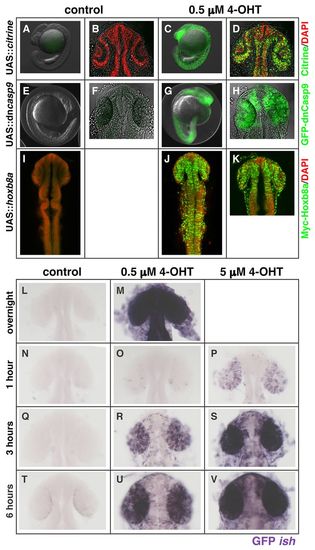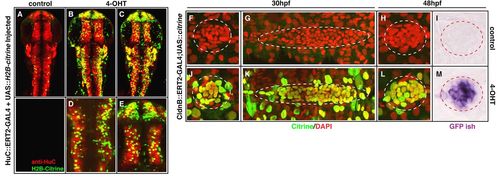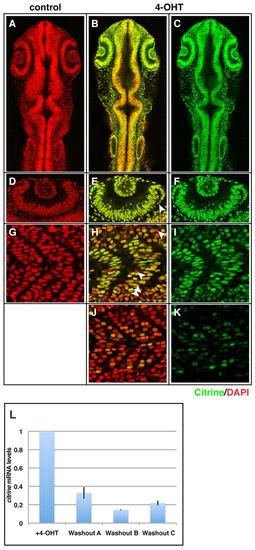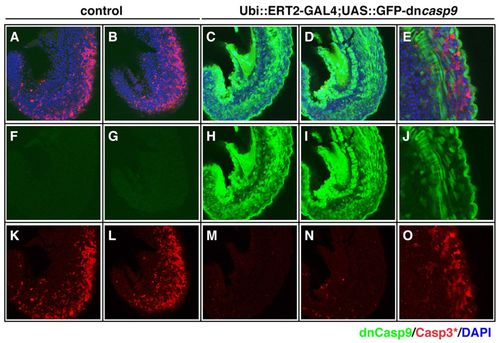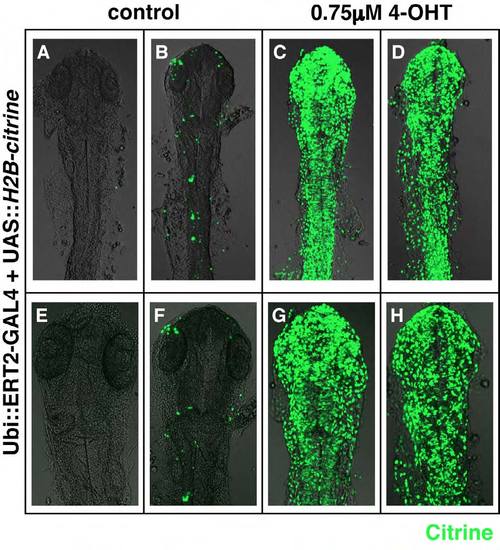- Title
-
An inducible transgene expression system for zebrafish and chick
- Authors
- Gerety, S.S., Breau, M.A., Sasai, N., Xu, Q., Briscoe, J., and Wilkinson, D.G.
- Source
- Full text @ Development
|
Activity of ERT2-GAL4 in vivo is 4-OHT dependent, rapid and dose sensitive. (A-K) Stable transgenic fish lines expressing ERT2-GAL4 under control of the Xenopus EF1α promoter show robust transactivation of UAS-linked H2B-citrine (C,D), GFP-dnCasp9 (G,H) or Myc-hoxb8a (J,K) when treated overnight with 0.5 μM 4-OHT (all in green channels), compared with controls (A,B,E,F,I, green channel). In some samples, nuclei are labelled with DAPI (B,D,I-K, red channel) and/or brightfield (A-H, grey) to visualize the embryo. (L-V) A time-course of UAS-linked transgene transcription (in situ hybridisation for GFP, purple) driven by ERT2-GAL4 shows 4-OHT dependence (controls in N,Q,T versus 4-OHT treated in O,R,U and P,S,V). The kinetics and intensity of response are dose dependent: embryos treated with 5 μM 4-OHT show more rapid, stronger and less mosaic transcription from the UAS-driven transgene than 0.5 μM 4-OHT-treated embryos (compare P,S,V with O,R,U) over the 6-hour treatment course. Embryos treated overnight with 0.5 μM 4-OHT (control in L, 4-OHT in M) show robust GFP transcription. The light pigmentation around the eye of embryos at 6 hours in T is not in situ signal. |
|
Tissue-specific ERT2-GAL4 produces 4-OHT-dependent, region restricted activity of transgene expression. (A-E) Transient transgenics in which ERT2-GAL4 is under control of the HuC enhancer/promoter show robust neuron-specific expression from co-injected UAS::H2B-citrine when embryos are treated overnight with 0.5 μM 4-OHT, compared with controls (compare B-E versus A, green channel). Staining with anti-HuC/D antibody reveals the endogenous expression pattern of this gene (A-E, red channel). Images in A-C are maximum projections of the entire embryo thickness (36-40 μm). Images in D,E are enlarged maximum projections of a 5.7 μm stack from embryo in C. (F-M) Stable transgenics in which cldnB enhancer/promoter drives ERT2-GAL4 show robust induction and 4-OHT dependence of a stable 5×UAS::H2B-citrine transgene (compare J,K,L versus F,G,H, green channel). When treated with 1 μM 4-OHT from 50% epiboly, embryos express Citrine in the migrating lateral line primordium and deposit neuromasts at 30 hpf (dotted ovals in K and J, respectively, green channel). Persistent expression of the UAS-linked citrine at 48 hpf in neuromasts is detected by in situ hybridisation for citrine transcript (compare M with I, red circled purple signal). Some samples were co-stained with DAPI to reveal nuclei (F-H,J-L, red channel). Additional Citrine-positive cells outside the lateral line structures in J-L reflect the expression of Cldnb in the skin. |
|
ERT2-GAL4 under the control of the ubiquitin promoter can drive widespread, 4-OHT-dependent activity to 24 hours post-fertilisation. (A-K) Stable ubi::ERT2-GAL4 lines were crossed to a UAS::H2B-citrine line, and embryos were treated overnight with ethanol (A,D,G) or 0.75 μM 4-OHT (B,C,E,F,H-K) from 50% epiboly to 21 hpf. Confocal analysis of single optical planes reveals near-ubiquitous GAL4 activity in a 4-OHT-dependent manner in one line (A,D,G versus B,C,E,F,H,I, Citrine in green channel, DAPI in red channel). Arrowheads indicate Citrine-negative cells. A second independent ubi::ERT2-GAL4 line showed much weaker and more mosaic expression (J,K versus H,I, Citrine in green channel, DAPI in red channel), suggesting insertion site-dependent effects on ubiquitin promoter activity. Representative Citrine-negative cells in E,H are indicated by arrowheads. (L) Upon withdrawal of 4-OHT from Citrine-positive embryos from 18 hpf to 42 hpf (24 hour withdrawal, washouts A, B and C), mRNA levels of citrine drop by 67-85% compared with embryos maintained in 4-OHT (+4-OHT) (n=3 clutches) (compare +4-OHT with washouts A, B and C). qPCR levels are relative to embryos maintained in 4-OHT. Error bars indicate ±s.e.m. (overall signficant difference between +4-OHT and washout conditions, t-test, P<0.002). |
|
ERT2-GAL4-driven expression is sufficient to generate gain-of-function phenotypes in vivo. (A-O) Embryos from a Ubiquitin::ERT2-GAL4 fish crossed to UAS::GFP-dnCasp9 fish were treated with ethanol (A,B,F,G,K,L) or 0.625 μM 4-OHT (C-E,H-J,M-O) from 50% epiboly to 18 hpf, followed by added treatment with 10 μM HA14-1 for 2 hours. Staining for activated caspase 3 (red channel) and GFP (green channel) reveals a rescue of HA14-1-induced apoptosis by widespread GAL4-induced expression of dominant-negative caspase 9 (compare K,L with M,N, red channel) in embryonic trunk. In embryos with mosaic GAL4 activity (E,J,O, GFP in green channel), the rescue of apoptosis is cell-autonomous to the GFP-dnCasp9-expressing cells (E,J,O, compare non-overlapping green and red). Samples were co-stained with DAPI (A-E, blue channel) to reveal nuclei of all cells. All images are side views of the trunk at 20 hpf. |
|
Transient ERT2-GAL4 expression under the control of the ubiquitin promoter drives widespread, 4-OHT dependent activity. One-cell stage embryos were co-injected with the Ubiquitin::ERT2-GAL4 and UAS::H2B-citrine plasmids, and were treated overnight with ethanol (control, A,B,E,F) or 0.75 μM 4-OHT (C,D,G,H) from 50% epiboly to 21 hpf. Embryo-wide GAL4 activity is revealed by the expression of Citrine in a 4-OHT-dependent manner (Citrine in green channel, dark field in grey channel). The non-uniform pattern of Citrine expression reflects the mosaic inheritance of plasmid DNA in transient transgenics. A small number of Citrine-positive cells are seen in untreated embryos (A,B,E,F), but not in stable transgenics bearing the same constructs (see Fig. 4). E-H are higher magnicifcation images from embryos in A-D, respectively. |

